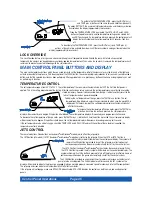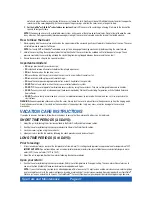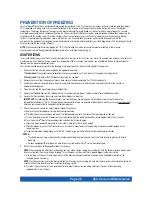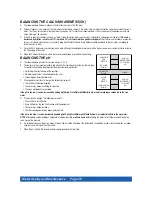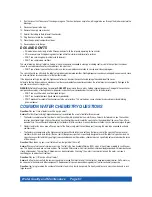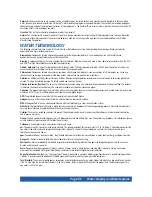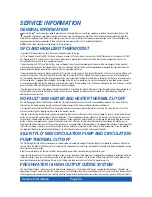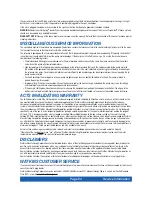
Page 49
CHLORINE (SODIUM DICHLOR)
A. Sanitizing chemicals, such as chlorine, are oxidants that kill bacteria and viruses in the water. The
Free Available Chlorine (FAC) is a measure of the amount of unused chlorine available to sanitize the
spa. The recommended FAC for your spa water is 3.0-5.0 ppm.
B. Watkins Manufacturing Corporation recommends the use of sodium dichlor type granulated
chlorine for sanitizing the water. Sodium dichlor is preferred because it is totally soluble, dissolves
quickly and is nearly pH neutral.
C. Maintaining the proper level of chlorine during use is extremely important.
D. If the FAC is too low, bacteria and viruses can grow rapidly in the warm water.
Increase the FAC
by adding granulated sodium dichlor.
E. If the FAC is too high, the water can cause discomfort to the user’s eyes, lungs and skin.
Simply
allow some time to pass. The FAC level will naturally drop over time.
F. When the Free Available Chlorine is within the recommended range, the spa is ready to be enjoyed.
WARNING:
There are several forms of stabilized chlorine available for use in spas and swimming
pools and each form has specific chemical characteristics. It is extremely important that the one
you choose is specifically designed for use in spas. Use of an incorrect product such as tri-chlor, which has a very low pH (2.6), dissolves too
quickly in hot water resulting in extremely high levels of chlorine, and is designed for concrete or plaster swimming pools,
WILL
cause
damage to your spa. Use of a liquid or any type of compressed bromine or chlorine, acid or any type of sanitizer which is not recommended
by Watkins Manufacturing Corporation
WILL
damage your spa and is specifically not covered under the terms of the limited warranty.
IMPORTANT:
Granulated chlorine (sodium dichlor) will degrade if stored improperly. We recommend purchasing chlorine in one , two, or five
pound containers and storing it in a cool, dry place to maintain its potency.
SUPER CHLORINATION
Super Chlorination is designed to “burn-off” the build-up of chloramines (used chlorine), to eliminate the chlorine smell and to allow the proper
level of free chlorine to be maintained.
When giving your water a super chlorination treatment, open the cover at least half way to allow the chlorine gas to vent off. The high
concentration of chlorine gas which may exist as a result of super chlorination (not daily sanitation) may eventually cause discoloration or
degradation to the bottom of the cover or the tile grouting, which would not be covered under the terms of your warranty.
IMPORTANT:
Always allow the Free Available Chlorine to fall below 5 ppm before using your spa.
WARNING:
Never leave an open spa unattended, especially if there are children present!
BUILDING A SANITIZER ROUTINE
During the first month of ownership, measure the sanitizer residual daily in order to establish standards for User Load and Usage Time versus
Sanitizer Needed.
• The User Load of the spa is the number of times anyone enters the spa.
• The Usage Time is simply the amount of time a user spends in the spa.
• Sanitizer Needed is the amount of Free Available Chlorine needed to accommodate the number of users and their combined usage time.
For example, two spa users who regularly use the spa once an evening for twenty minutes create a specific and somewhat consistent demand on
the sanitizer. During the first month of ownership, these two users can determine exactly how much sanitizer to use in order to maintain the proper
residual. If, at any time, the user load and/or usage pattern changes dramatically (invited guests), the amount and frequency of sanitizer required
increases dramatically.
The greater the usage time, or the bather load, the faster the residual value is diminished.
SUPPLEMENTAL WATER MAINTENANCE
Proper water sanitation and mineral balance (pH control) are absolutely essential for a complete spa water maintenance program. Here are three
other popular water additives that are optional:
Mineral Deposit Inhibitors
As water evaporates from your spa and new water is added, the amount of dissolved minerals will increase. (Minimize evaporation by keeping the
cover on the spa whenever possible.) The spa water may eventually become “hard” (Calcium Hardness too high) enough to damage the heater by
calcifying its surface. Proper pH control can minimize this.
Normal soap build-up will require water replacement regularly enough that mineral deposits normally are not a problem.
Occasionally, high iron or copper content in the water may produce green or brown stains on the spa. A stain and scale inhibitor may help to
reduce these metals.
Water Quality and Maintenance

